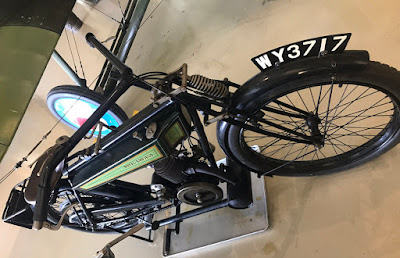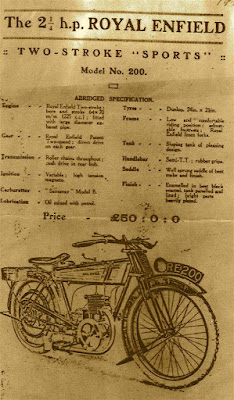 |
| It was a little Royal Enfield tiddler of the 1920s. But note the footpeg. |
That's thanks to Sarah Dunne, archivist and librarian at the museum, and to Paul d'Orleans, author and editor of TheVintagent website, who once owned a similar Royal Enfield and wrote an article about it.
Plus, both Sarah and Paul had letters, written in the 1980s, by a Royal Enfield expert, that together shed light on the Royal Enfield two-and-a quarter horsepower Model 200 of the early 1920s.
Sarah looked up for me what the museum knows about its motorcycle:
"The registration number is WY3717, the engine number is E9361, the magneto number is 890T, and it has a Brown & Barlow carburetor. In 1980 the museum corresponded with several Enfield aficionados in an attempt to find out more about the bike; we had very little information on it then, not even the year," she wrote.
"After some dead ends, we were referred to the wonderfully named Ivor Mutton, with whose name you are almost certainly familiar but was new to me. I'm attaching a scan of his letter. He backs up your surmise that the registration was from West Yorkshire. A handwritten note in our records indicates that the bike had been purchased by a previous owner, a Pennsylvania resident, as a 1919 model. There are photocopies of what I believe is a 1966 Pennsylvania registration slip for the bike.
"Our ground vehicle conservator says that he believes the pegs are wrong but that the rest of the bike appears to be correct. It is a runner; we haven't started it or ridden it around since early this summer, but it had no major problems then." (Since this was written, she advises that volunteers have again had it running this summer.)
Oh, those pegs. I had noticed that the museum's Royal Enfield has foot pegs instead of floorboards. Period ads show this model with floorboards and 1922 seems too early to me for foot pegs to appear on motorcycles.
(The Barber Vintage Motorsports Museum in Birmingham, Ala. has a 1926 Royal Enfield Model 200 with footpegs but it shows other evidence of progress since 1922, including a proper gearshift lever on the side of the tank instead of the coffee-grinder handle above the tank on the Royal Enfield in the Owls Head Transportation Museum.)
In his 1980 letter to Owls Head, Mr. Mutton (the now deceased specialist on Royal Enfields for the Vintage Motor Cycle Club in the UK) notes the lack of floorboards, and considers them "missing."
 |
| 1980 letter to the museum from Ivor Mutton, Royal Enfield authority in Redditch, England. |
In it Paul describes his Royal Enfield two-and-a-quarter of the same vintage (1921 not 1922), and publishes photos of it. Amazingly, he believes his motorcycle was a "Sports Model" further modified as a factory racer for a noted competitor of the time.
Who would race such a seemingly toy-like motorcycle? Paul's article explains that the little Royal Enfield had a number of competitive advantages in its day.
It used chain final drive in an era when many motorcycles used troublesome belts. And there was that two-speed transmission, which, he points out, was not a true gearbox. Instead, there are two primary chains between crankshaft and clutch. The coffee-grinder handle above the tank chooses between the two — "a very simple system," he calls it.
The photos show that his motorcycle has what appear to be the same sort of foot pegs that are on the Owls Head motorcycle!
Paul's article reprints a 1982 letter from Mr. Mutton, written in reply to a request for information about the motorcycle Paul would later purchase (and has since sold on).
In his reply, Mr. Mutton wrote that the Sports Model was only introduced in 1922, but that the factory could have built some 1922s in 1921.
Mr. Mutton sent with that letter two Royal Enfield factory images showing the Sports Model — both show that the "Sports Model" would have had foot pegs.
 |
| Royal Enfield advertisement for the Model 200 Sports. It shows footpeg and specifies "adjustable footrests" are included. |
Either he is too specific about all these or the museum motorcycle is perhaps a non-Sports model jazzed up with the available factory foot pegs.
Does it matter? Only for fun.
Perhaps the greatest surprise at all is that in the 1920s people actively raced Royal Enfield 225cc two-stroke motorcycles.


























No comments:
Post a Comment